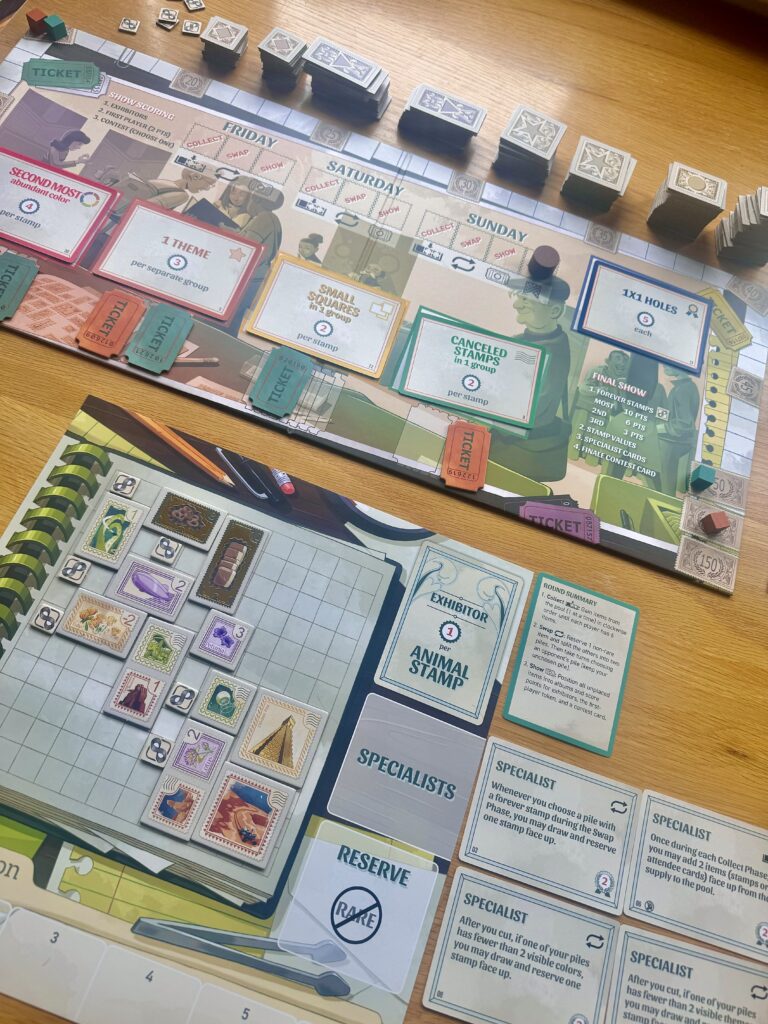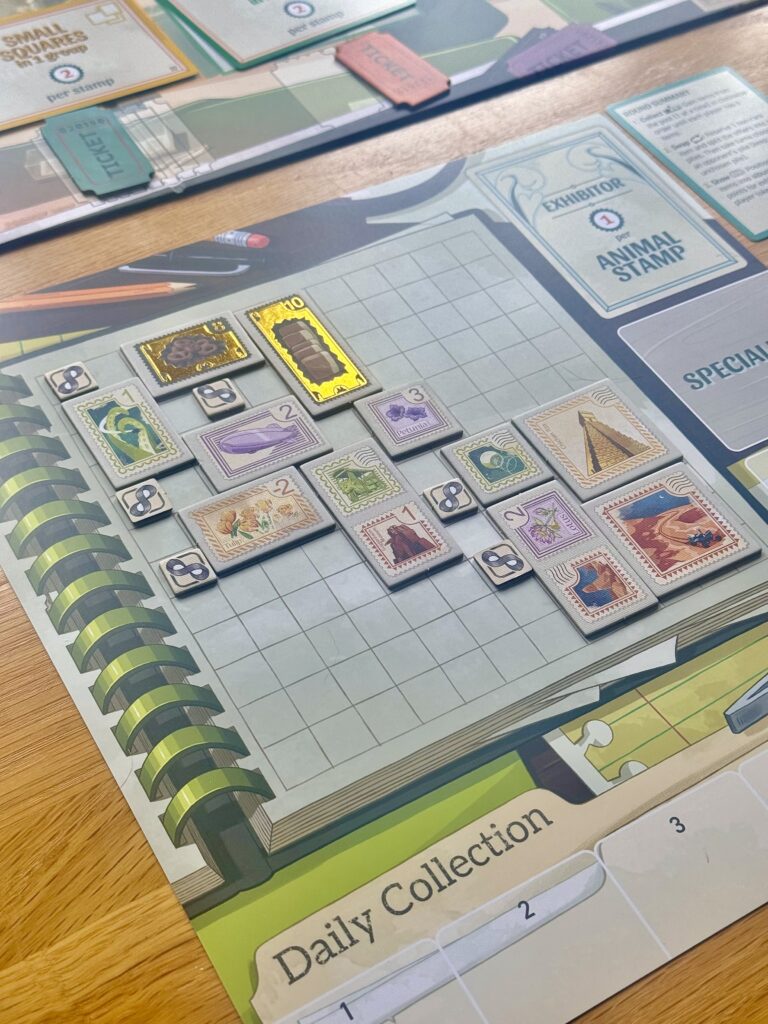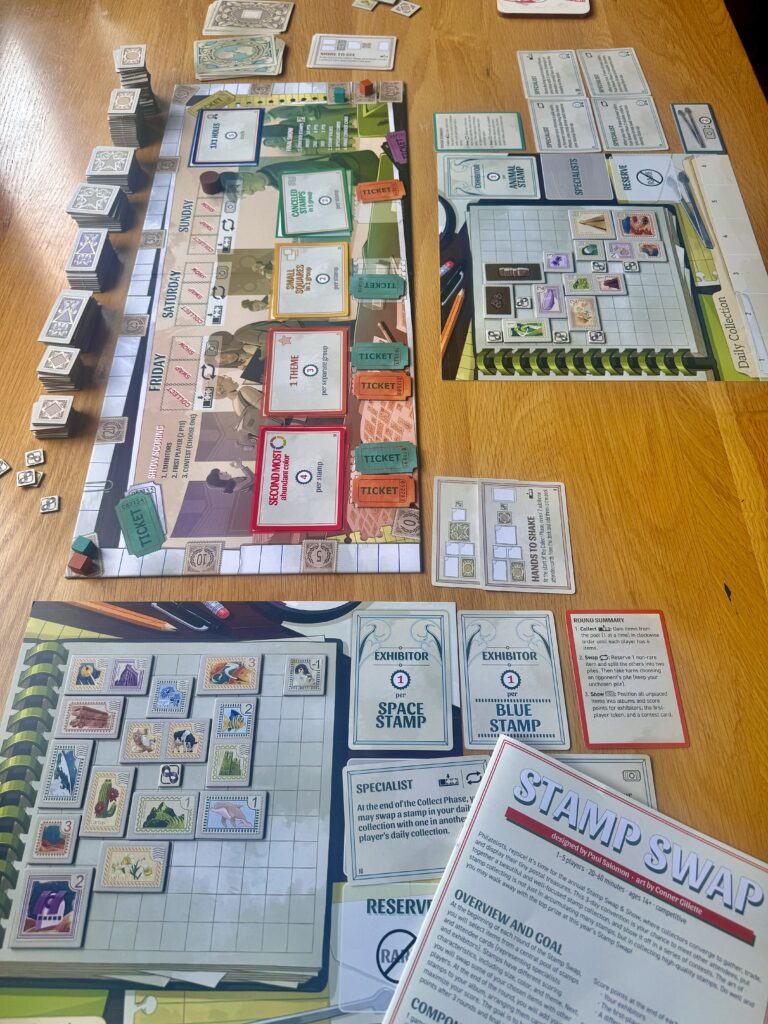Stamp Swap challenges you to draft and swap your way to the crown
Calling all fellow philatelists it’s time for the Stamp Swap show. Converge on this collection convention to see who will be named the curation king (or queen) following three fast paced rounds of drafting and swapping. Watch out for those pesky faded stamps.
Stamp Swap is the latest offering from Stonemaier games. Designed by Paul Salomon with artwork by Conner Gillette Stamp Swap casts players as stamp collectors seeking to build the most valuable collection by selecting and meeting different scoring goals as well as recruiting exhibiters and specialists over three identical rounds. The third and final round is immediately followed by the final scoring phase in which all players will score against the same finale goal.
 Each round consists of three phases. First is the collect phase in which players will take turns selecting one item at a time-usually one of the various stamp types but there are also attendee cards (exhibitors and specialists) and the first player token-and adding it to the daily take in their player area. Some stamps are face down so while players can still see their shape and size the theme and colour remain a mystery until they are selected (the active player can then secretly view them once taken but they still remain face down to others). There are five possible themes such as animal or flower stamps and five different colours. There are also forever stamps (the smallest type) and rare gold foil stamps which look great and seem to feature a lot of delicious looking chocolatey treats.
Each round consists of three phases. First is the collect phase in which players will take turns selecting one item at a time-usually one of the various stamp types but there are also attendee cards (exhibitors and specialists) and the first player token-and adding it to the daily take in their player area. Some stamps are face down so while players can still see their shape and size the theme and colour remain a mystery until they are selected (the active player can then secretly view them once taken but they still remain face down to others). There are five possible themes such as animal or flower stamps and five different colours. There are also forever stamps (the smallest type) and rare gold foil stamps which look great and seem to feature a lot of delicious looking chocolatey treats.
Once all players have amassed six items it’s time for the swap phase. After reserving one item straight to their board for keeps(not rare stamps, these must always be risked in the piles) players simultaneously splits their new items into two piles on offer for the other collectors. Face down stamps must remain face down for this stage. Then the holder of the first player token chooses and takes one of the piles on offer from an opponent, that opponent then immediately receives everything in their rejected pile and then chooses an opponents pile themselves and so on until every player has received one of their own piles rejected by the others and chosen one from another player.
Finally once all items have been claimed the show phase begins. Attendee cards gained are locked in place and stamps are placed strategically on their album grid with a mind to the scoring goals (more on this soon). Once placed they cannot be moved. Once players have committed to stamp placements the round is scored using three criteria. First exhibitor card requirements are checked, for example you might gain one point for every space themed stamp in your collection. The first player token is worth two points if taken. Lastly players must spend one of their three tickets to enter and score in one of the four available contests. Contests might be things such as how many stamps of a certain theme or size or the largest collection of cancelled stamps in a single group. The common pool is then replenished ready for the next collect phase.
At the close of the third round the show phase is immediately followed by final show scoring. Collectors will score for forever stamps based on who has the most, second most and third most. Players then total the value of their stamps (some are negative) and score two points for each specialist card before scoring the finale contest card which rewards players based on how carefully they have filled their grid with stamps. For example each complete edge may score or perhaps each completely enclosed and surrounded stamp.
Stamp Swap offers a good challenge and plenty to think about from a pleasingly slim rule set. I enjoyed the puzzle of trying to work out what to put in each pile during the swap phase. Make one pile too obviously high scoring for you and it might just get swiped on the other hand you could put one or two face down stamps in that pile to make it seem a risky prospect but then you might end up with those negative value stamps if the pile is left. This tension during the selecting of the piles and trying to make sure that ending up with either would still be beneficial was my favourite part of the game.
Placing the stamps on your grid is an engaging puzzle as you try and balance your existing collection with the goals on offer and what you may acquire in future rounds. Do you keep that dog stamp in your animal theme group or is it better of in the corner where you are working on as many yellow stamps as possible because you noticed another player going for animals but no one’s hitting yellow hard yet.
There is a good amount of variability on show. Each round is given a unique condition by the event card drawn and there are a total of thirty contest cards across the five categories so there will be different combinations of goals to shoot for every game.

The specialist cards also do a good job of shaking things up and giving each player a different angle to work with. My favourite one allowed me to swap a stamp with a rival at the end of the collection phase and before the swap. Meaning if they had sneakily swiped something I had my eye on I could pinch it back and palm off one of my worst picks on them. Some of the other specialist cards allowed players to add stamps to the pool or preview face down stamps before choosing.
All in all Stamp Swap is a great package that’s easy to teach and learn. There’s some interesting puzzles and trade offs to negotiate and a solid amount of variability. Don’t let the theme put you of, I honestly enjoyed this a lot more than I expected, the drafting system is tense and fast paced and constantly forces you to prioritise and refocus as what you wanted is often gone by your next turn, especially with four or five players. The game scaled really well too different player counts. It’s cosy with two and ruthless with five. It receives my stamp of approval.
Stamp Swap is available now from Amazon as well as other retailers.
Comments are closed.